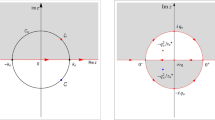Abstract
In this article we develop the direct and inverse scattering theory of a discrete matrix Zakharov-Shabat system with solutions U n and W n . Contrary to the discretization scheme enacted by Ablowitz and Ladik, a central difference scheme is applied to the positional derivative term in the matrix Zakharov-Shabat system to arrive at a different discrete linear system. The major effect of the new discretization is that we no longer need the following two conditions in theories based on the Ablowitz-Ladik discretization: (a) invertibility of I N −U n W n and I M −W n U n , and (b) I N −U n W n and I M −W n U n being nonzero multiples of the respective identity matrices I N and I M .
Similar content being viewed by others
References
Ablowitz, M.J., Biondini, G., Prinari, B.: Inverse scattering transform for the integrable nonlinear Schrödinger equation with nonvanishing boundary conditions. Inverse Probl. 23, 1711–1758 (2007)
Ablowitz, M.J., Ladik, J.F.: Nonlinear differential-difference equations. J. Math. Phys. 16, 598–603 (1975)
Ablowitz, M.J., Ladik, J.F.: A nonlinear difference scheme and inverse scattering. Stud. Appl. Math. 55, 213–229 (1976)
Ablowitz, M.J., Ladik, J.F.: Nonlinear differential-difference equations and Fourier analysis. J. Math. Phys. 17, 1011–1018 (1976)
Ablowitz, M.J., Ohta, Y., Trubatch, A.D.: On discretizations of the vector nonlinear Schrödinger equation. Phys. Lett. A 253, 287–304 (1999)
Ablowitz, M.J., Prinari, B., Trubatch, A.D.: Discrete and Continuous Nonlinear Schrödinger Systems. London Math. Soc. Lecture Notes Series, vol. 302. Cambridge Univ. Press, Cambridge (2004)
Cai, D., Bishop, A.P., Grønbech-Jensen, N.: Spatially localized, temporally quasi-periodic, discrete nonlinear excitations. Phys. Rev. E 52, 5784–5787 (1995)
Deift, P., Trubowitz, E.: Inverse scattering on the line. Commun. Pure Appl. Math. 32, 121–251 (1979)
Demontis, F.: Matrix Zakharov-Shabat System and Inverse Scattering Transform. Lambert Academic, Saarbrücken (2012). Also: F. Demontis, Direct and Inverse Scattering of the Matrix Zakharov-Shabat System, Ph.D. thesis, University of Cagliari, Italy, 2007
Demontis, F., van der Mee, C.: Exact solutions to the integrable discrete nonlinear Schrödinger equation under a quasiscalarity condition. Commun. Appl. Ind. Math. 2(2), e-372 (2011), 21 pp.
Demontis, F., van der Mee, C.: Closed form solutions to the integrable discrete nonlinear Schrödinger equation. J. Nonlinear Math. Phys. 19(2), 1250010 (2012), 22 pp.
Doliwa, A., Santini, P.M.: Integrable dynamics of a discrete curve and the Ablowitz-Ladik hierarchy. J. Math. Phys. 36, 1259–1273 (1995)
Faddeev, L.D.: Properties of the S- matrix of the one-dimensional Schrödinger equation. Transl. Am. Math. Soc. 2, 139–166 (1964); also: Trudy Mat. Inst. Steklova 73, 314–336 (1964) [Russian]
Gerdjikov, V.S., Ivanov, M.I.: Block discrete Zakharov-Shabat system. I. Generalized Fourier expansion, United Nuclear Research Institute Report E2-81-811, Dubna, 1981
Gerdjikov, V.S., Ivanov, M.I.: Block discrete Zakharov-Shabat system. I. Hamiltonian structures, United Nuclear Research Institute Report E2-81-812, Dubna, 1981
Hasegawa, A., Matsumoto, M.: Optical Solitons in Fibers, 3rd edn. Springer, Berlin (2002)
Hasegawa, A., Tappert, F.: Transmission of stationary nonlinear optical pulses in dispersive dielectric fibers. I. Anomalous dispersion. Appl. Phys. Lett. 23, 142–144 (1973)
Hisakado, M., Wadati, M.: Integrable dynamics of discrete surfaces. II. J. Phys. Soc. Jpn. 65, 389–393 (1996)
Klaus, M.: Low-energy behaviour of the scattering matrix for the Schrödinger equation on the line. Inverse Probl. 4, 505–512 (1988)
Kulish, P.P.: Quantum difference nonlinear Schrödinger equation. Lett. Math. Phys. 5, 191–197 (1981)
Lakshmikantham, V., Trigiante, D.: Theory of Difference Equations: Numerical Methods and Applications. Mathematics in Science and Engineering, vol. 181. Academic Press, New York (1988)
Manakov, S.V.: On the theory of two-dimensional stationary self-focusing of electromagnetic waves. Sov. Phys. JETP 38, 248–253 (1974)
Suris, Y.B.: A note on an integrable discretization of the nonlinear Schrödinger equation. Inverse Probl. 13, 1121–1136 (1997)
Tsuchida, T., Ujino, H., Wadati, M.: Integrable semi-discretization of the coupled nonlinear Schrödinger equations. J. Phys. A 32, 2239–2262 (1999)
Vekslerchik, V.E., Konotop, V.V.: Discrete nonlinear Schrödinger equation under non-vanishing boundary conditions. Inverse Probl. 8, 889–909 (1992)
Wiener, N.: The Fourier Integral and Certain of Its Applications. Dover, New York (1959); also: Cambridge Univ. Press, Cambridge (1933)
Zakharov, V.E., Shabat, A.B.: Exact theory of two-dimensional self-focusing and one dimensional self-modulation of waves in nonlinear media. Sov. Phys. JETP 34, 62–69 (1972)
Acknowledgements
F. Demontis research supported by INdAM, MIUR under PRIN grant No. 20083KLJEZ-003, and the Autonomous Region of Sardinia (RAS) under grant CRP3-138, L.R. 7/2007.
C. van der Mee research supported by RAS under grant PO Sardegna 2007-2013, L.R. 7/2007.
Author information
Authors and Affiliations
Corresponding author
Appendices
Appendix A: Summation by Parts Formula
Let \(\{b_{k}\}_{k=n}^{\infty}\) be a sequence of nonnegative numbers. Then in [6, Lemma A.2] the following fundamental equality has been established:
where \(B_{n}^{(m)}\ge B_{n+1}^{(m)}\ge B_{n+2}^{(m)}\ge\cdots\ge0\).
Although the general form of the discrete Gronwall inequality is well-known [21, Corollary 1.6.2], here we apply (A.1) to prove the version needed.
Proposition A.1
(Gronwall’s inequality)
Suppose \(\{p_{k}\}_{k=n}^{\infty}\) and \(\{q_{k}\}_{k=n}^{\infty}\) are sequences of nonnegative numbers such that the series \(\sum_{k=n+1}^{\infty}q_{k}\) converges and
Then
Proof
Iterating (A.2) we get

where (A.1) has been used repeatedly. □
Appendix B: Marchenko Equations in More Detail
In this appendix, we decouple (5.6a)–(5.6d) by using that the Marchenko kernels vanish for even values of their arguments. Equations (B.1a)–(B.3d) below have been used in [11] to derive explicit matrix IDNLS solutions by using matrix triplets to parametrize the Marchenko kernels.
Let us decouple (5.6a) and (5.6b), using that the Marchenko kernels F r (s) and \(\overline {\boldsymbol {F}}_{r}(s)\) vanish for even s. We get




Equations (B.1a) and (B.1d) are valid for σ≥1, whereas (B.1b) and (B.1c) are valid for σ≥0. This distinction in the ranges of the summation index σ is to bear in mind when deriving exact solutions to (1.5). The potentials are then computed as follows:
Let us decouple (5.6c) and (5.6d), using that the Marchenko kernels F l (s) and \(\overline {\boldsymbol {F}}_{l}(s)\) vanish for even s. We get




Equations (B.3a) and (B.3d) are valid for σ≥1, whereas (B.3b) and (B.3c) are valid for σ≥0. This distinction in the ranges of the summation index σ is to bear in mind when deriving exact solutions of (1.5). The potentials are then computed as follows:
Rights and permissions
About this article
Cite this article
Demontis, F., van der Mee, C. An Alternative Approach to Integrable Discrete Nonlinear Schrödinger Equations. Acta Appl Math 127, 169–191 (2013). https://doi.org/10.1007/s10440-012-9797-9
Received:
Accepted:
Published:
Issue Date:
DOI: https://doi.org/10.1007/s10440-012-9797-9




